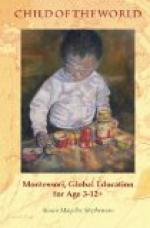Shriek, wind, shriek!
Make the branches creak!
Battle with the boughs till break of day!
In a snow cave warm and tight
Through the icy winter night
The rabbit sleeps the peaceful hour away.
Scold, wind, scold!
So bitter and so bold!
Shake the windows with your tap, tap,
tap!
With half-shut, dreamy eyes
The drowsy baby lies
Cuddled closely in his mother’s
lap.
—MARY F. BUTTS.
HOPE’S DOLL
It was Saturday morning. Elizabeth Brown sat by a window in the big kitchen making a pink dress for little Hope’s doll.
On the chair beside her lay the doll, though you might not have thought of calling it one. It did not have curly hair—nor eyes that open and shut. In those days no child had toys like ours. Hope’s doll was made of a corncob; the face was painted on a piece of linen stretched over a ball of wool on the end of the cob.
Little Hope was taking her morning nap. When Elizabeth had sewed the last neat stitches, she dressed the doll and laid it on the bed by the little girl. How happy Hope was when she awoke and saw it! She thought it the most beautiful doll in the world.
“What will you call your doll, Hope?” asked Elizabeth.
“I will name her for mother,” said Hope. “I will call her Mary Ellen.”
[Illustration: Hope and her doll]
Hope played all the afternoon with her doll and was very happy. When the sunset gun sounded, she had to stop playing. With the Puritans, the Sabbath began at sunset, and no child could play after the gun was heard.
The little maid kissed her baby and went into the bedroom to find a warm place for it to stay until the next evening. There lay father’s Sunday coat; what warmer nest could she find for Mary Ellen than its big pocket?
After breakfast the next day, every one got ready to go to meeting. Master Brown filled the little tin foot stove with hot coals from the hearth; then he took his gun from its hook. In those days no man went anywhere without his gun—not even to church, for the Indians were likely to come at any time.
Sometimes the firing of a gun was the call to worship. More often a big drum, beaten on the steps of the meeting house, told the people it was time to come together.
At the sound of the drum, Master Brown and his wife, with Elizabeth and Hope, started to church. From every house in the village came men, women, and children. They were always ready when the drum began to beat, for no one was ever late to meeting in those days.
Master Brown led his family to their pew and opened a little door to let them in. The pew was very much like a large box with seats around the sides.
The church was cold, for there was no fire. The children warmed their fingers and toes by the queer little foot stove their father had brought from home.




